How do you avoid the dreaded infodump while still giving your readers the information they need to understand your story?
http://elizabethspanncraig.com/2515/write-compelling-balanced-backstory/
Viewing: Blog Posts Tagged with: print, Most Recent at Top [Help]
Results 1 - 25 of 39
Blog: Just the Facts, Ma'am (Login to Add to MyJacketFlap)
JacketFlap tags: backstory, Add a tag
Blog: Guide to Literary Agents (Login to Add to MyJacketFlap)
JacketFlap tags: Craft & Technique, Marketing & Self-Promotion, There Are No Rules Blog by the Editors of Writer's Digest, shennandoah diaz, podcast, General, blogging, short story, backstory, Guest Post, Add a tag
BY SHENNANDOAH DIAZ
Backstory is crucial to the novel writing process. It gives your character substance and drive while adding depth, history and realism to your fiction. It takes a great deal of hard work to develop your character’s backstory. Unfortunately for the sake of the novel, much of that hard work ends up on the cutting room floor.
That doesn’t mean all that hard work has gone to waste. There are many ways for you to repurpose those backstories into moneymaking and author platform building opportunities.

Shennandoah Diaz is a writer and freelance Branding and Communications expert based out of Austin, Texas. Diaz works with independent publishers, small businesses, experts, and authors to build killer brands and engaging content. Passionate about education, Diaz teaches workshops for the Writer’s League of Texas and other professional organizations that empower writers to take charge of their brand and their writing career. Learn more by visiting shennandoahdiaz.com or follow her on Twitter (@shennandoahdiaz).
1. Short Stories for Submission
Often our character backstory is centered on a core event that changes the character’s life in a big way. That dramatic event is a great point of focus for a short story. Short stories can range from flash fiction as short as six words to works as long as 5,000–20,000 words. There are dozens of contests and outlets, both paying and non-paying, that publish short stories on a continual basis. Some outlets that post these opportunities include Duotrope, local writing groups, area universities, and of course there are several competitions throughout the year hosted by Writer’s Digest. Duotrope also allows you to create an account to track submissions so you know what you sent, where, and when.
Each published piece is more than just a feather in your cap. It helps you prove your characters’ appeal and story premise in a paying market, demonstrates that you are a writer who can deliver, and helps you start getting paid for the work you’re already doing.
2. Website Freebies
It is crucial for an author to invest in building his or her platform on an ongoing basis. Digital media requires regular content to attract attention and followers. Backstories packaged as short stories, blog posts and vignettes make great content for author websites and fans. You can wait until after you’ve tried publishing through a paying outlet, or go ahead and offer it as a free download on your website as a way to attract readers and thank your existing fans.
Just remember to edit carefully, and if possible, get a second pair of eyes on your work before you post it for the world to see. There are many freelance editors available who can provide a professional critique of your work for a nominal fee. The expense is worth it when it comes to your website and author platform development. You want to make sure you’re always putting your best foot forward, and don’t want to get caught posting a story that doesn’t flow or that contains improper grammar.
The nonfiction research you did for your story is also great to share. The nonfiction or “truth” side to every story is a major contributor to creating interest for your book. Did you research vintage balloons for your story? Write a blog post about it. Did you visit an old ghost town for the setting of your novel? Share the pictures you took. Maps, historical information, how-tos, diagrams and other informative pieces bring life and context to your work. Most of all, they draw in readers. Share your research as blog posts, downloads, and images. You’ll be surprised how many people you reach that might not have connected with you otherwise.
3. Multimedia
Stories are told through many media, not just the written word. Video, music, photography, and other art forms are also great ways to convey and share your character’s backstory. Pair up with a local aspiring film director to turn your backstory into a screenplay for a short filmt, or take a cue from Scott Sigler and post the screenplay as a competition for your followers. You can even take it a step further and use your backstories for a series of podcasts to drum up interest in your work.
If you have a pile of nonfiction research on a historic place, profession, or some other aspect of your story, you can turn those into interesting how-to videos and informative podcasts. Many fiction authors have become subject matter experts on things like espionage and dead presidents by employing practices such as these. There are several inexpensive tools available.
Camtasia is great for doing professional looking videos that capture images and presentations on your computer screen. The interface is very simple and easy to use, and there are dozens of tutorials available to get you started. Animoto is great for making mini-videos using photos and stock clips, and requires little to no technical expertise. Their existing storehouse of images and music make it easy to create and share book trailers and mini informative videos in a matter of minutes.
Podcasts have become increasingly popular due to iTunes and online media such as BlogTalk Radio. There are several Podcast tools that let you record right from your computer. You can offer podcasts directly on your website or use mass distributors like iTunes and BlogTalk Radio to reach a wider audience based on topics of interests.
Really there are no limits as to how you can repackage your stories and research. You already did the work. Now it’s time to make it work for you.
Add a CommentBlog: Darcy Pattison's Revision Notes (Login to Add to MyJacketFlap)
JacketFlap tags: backstory, emotional depth, motivation, Characters, characterization, Add a tag

A quest for a new home--
An immigrant's story
"Watership Down" with armadillos
READ A SAMPLE CHAPTER!I am hard at work on an outline/synopsis sort of thingy for a new trilogy. I wish I could say it’s a true outline or synopsis, but I’m not an outliner. However, I’m not a panster either, to just start writing and write by the seat of my pants. I am a plan-ster, a person who halfway plans and then writes a while, and then plans again from the new and improved position halfway through the story.
While I’m outlining (term used loosely, as just explained), I am finding places where I am stuck. What happens next?
One word is changing things: Because.
My character argues with another BECAUSE. . .
By forcing myself to answer the BECAUSE question, I wind up going deeper into backstory, motivations and emotional depth. Why are they doing such and so? BECAUSE. . .
Backstory. Some of the because has to do with inventing backstory. This week, I found a villain that way. I knew Character V was acting up, but when I added the BECAUSE and started delving into V’s psychology and backstory, suddenly V took on a new–and much more interesting–role in the story. He became the antagonist, which I knew I needed, but I had been avoiding the work needed to figure it out. So, the BECAUSE work became a shortcut to finding out about a villain.
Motivations. For all the characters, the BECAUSE work meant I had to delve into the reasons for actions, the motivations. This deepened the story in important ways, even at this outline level. Partly, I am trying to find connections among characters and how they approach life at interesting tangents. As I worked on the BECAUSE answers, I made sure the answers weren’t clones, but held the possibility of interesting clashes.
Emotional Depth. This is saying the same thing as motivations in a different way, but it’s an important variation. Emotion is hard for me to pull into a story and planning for it up front is essential–or else my stories will be flat and revisions will be deadly. One question that helps here is, “Who hurts the most? X hurts the most BECAUSE. . .”
Fiction is about emotional conflict and how that conflict is resolved (or not). Generally, the person who hurts the most should be the main character. It’s not unusual to have to change the MC to a different character as you uncover and create the characters’ inner lives.
I am still stumbling around inside the ideas for this story. But one word is lighting a path toward actually writing a first draft: BECAUSE.
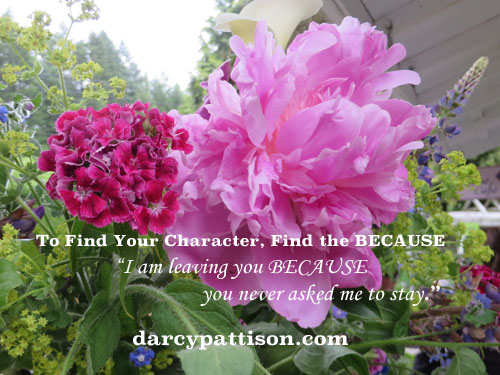
Blog: Emmasaries (Login to Add to MyJacketFlap)
JacketFlap tags: Writing YA, character memory, info-dumping, writing tips, Blog, childrens books, writing, backstory, middle grade novels, Add a tag
 Backstory can be essential to understanding a character and his/her journey. It can deepen conflict, reveal motivation and elicit sympathy for a hero or secondary character.
Backstory can be essential to understanding a character and his/her journey. It can deepen conflict, reveal motivation and elicit sympathy for a hero or secondary character.
But…
Nothing can kill pacing faster than an info-dump of backstory, especially in the first half of a novel. So when and how best to include it?
Here are 5 tips on how to artfully weave backstory into a middle grade or YA novel:
- Hint at your character’s backstory early on, but hold off on revealing it until the information is crucial for readers – or characters – to know.
- Reveal it piecemeal. Instead of an extended flashback, pick 2 or 3 key moments you can drop in here and there in small chunks – a sentence or two at a time, rather than paragraphs. This allows your reader to play detective and piece the clues together to form the whole picture.
- Have it be activated by something sensory – a sight, smell, sound, taste or feeling. These are powerful memory triggers, and can connect a present experience to a past one, making the details of the backstory feel more germane.
- Put it in a moment of interiority. (This only works if you are writing in 1st or close 3rd person, of course.)
- Reveal it in as few words as possible, artfully chosen. How many of those lyrical details do you really need? Let go of the writerly padding, no matter how much you love the imagery, and focus on the details that move the story forward. Young readers are less interested in backstory than they are in forward moving action.
For more writing and revision tips and tools such as this, take one of my home-study writing courses – Just Write for Kids, Just Write for Middle Grade or Just Write for Young Adults.
Visit: http://justwritechildrensbooks.com for details.
Blog: Writing for Children with Karen Cioffi (Login to Add to MyJacketFlap)
JacketFlap tags: writing tips, backstory, writing fiction, superhero origin stories, Add a tag
Guest Post by Carolyn Howard-JohnsonMy husband—sweetie that he is—brought me a copy of The Smithsonian from his dermatologist's office. So thanks to Lance and Dr. Mantel, I am now a diehard fan of the magazine.One of the articles was inspired by the new movie, Man of Steel. They take up how "superhero origin stories inspire us to cope with adversity."The elements that make superheroes so
Blog: Just the Facts, Ma'am (Login to Add to MyJacketFlap)
JacketFlap tags: backstory, openings, Add a tag
Your reader doesn't need to know everything about your characters and setting in the first few pages of your novel.
http://mysterywritingismurder.blogspot.com/2013/04/dont-be-information-dumper-guest-post.html
Blog: Inkygirl: Daily Diversions For Writers (Login to Add to MyJacketFlap)
JacketFlap tags: backstory, action, dating, Comics for writers, Add a tag
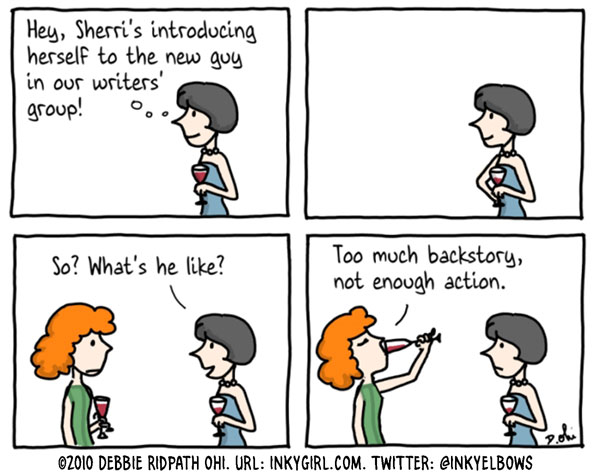
Originally posted in Writer Unboxed. See my other comics in Writer Unboxed.
Blog: Buzz, Balls & Hype (Login to Add to MyJacketFlap)
JacketFlap tags: Backstory, Add a tag
Note from M.J. - I'm moving the Backstory blog that I've had since 2006, here. On Friday's BB&H will be a place where authors share the secrets, truths, logical and illogical moments that sparked their fiction or memoirs. Today I have a special backstory - since this is a book I've read and loved!
A Sweet, No-Bake Tale of Success by Therese Walsh.
You are a lover of words. One day, you will write a book.
That fortune, cracked free of a cookie after eating my favorite Chinese meal of chicken and broccoli (extra spicy), resonated with me. I did love words. I did want to write a book. In fact, I’d been writing children’s picture book manuscripts for over a year. I wasn’t choosing the right sort of words for children’s books, though—words like “Go, dog. Go.” I liked words that filled a mouth with multiple syllables and a mind with interesting possibilities—words like unbounded and asymmetry and cryptophasia and hallucination.
So, with the fortune cookie slip before me, I began writing a novel for adults. The year: 2002. I intended it to be a romance, because I had a friend who loved the genre. But the story wanted to grow beyond the traditional bounds of romance; there were twin sisters here with something to say—about a tragedy and music and misunderstandings—not to mention a Javanese artifact, an antique dagger called a keris, bent on having a starring role.
Two years later, after hacking 40,000 words off the manuscript and polishing the surviving sentences, I queried agents, still not 100% sure of what I’d written. Turns out, I wasn’t alone.
“The premise of your book is compelling and the writing evocative,” one agent wrote in her rejection letter, “but the tone and set-up make this novel a bit difficult to categorize.”
“The scope of your novel is too broad for a contemporary romance,” said another.
Agent Deidre Knight took the time to explain why the manuscript would be a difficult sell: While the love story drove the plot, the relationship between the sisters provided the most intense emotional moments. “My gut tells me you probably have a part of you that either wants to write women’s fic, or that ultimately *will* write women’s fic,” she said. “My gut tells me you need to write something bigger than romance.”
This? Depressing. I’d worked on the story for so long, making time for it while mothering my two children and between nonfiction jobs (I’d been a freelance health writer). I’d given up sleep. Given up television. My fortune cookie slip hadn’t predicted failure.
I tried to work on something new, but the desire to do my already rejected story justice gnawed at me. Eventually, I committed to a rewrite. I tucked the first incarnation of the tale into a box, and focused on the twins, looking for more. What hadn’t these characters already revealed to me? I cast off my developed notions about who they were, what they wanted, even whose story needed to be told. I decided to interweave narratives to better explore Maeve and Moira Leahy’s unique, magical relationship. I added new characters, left old ones to molder on the cutting-room floor. I turned the plot on its ear. I studied my craft.
Three years and several gray hairs later, I finished writing my 400-page manuscript for the second time and editing it for the 100th. There was still a love story there, along with elements from other genres—mystery, suspense, even mythical realism. But this time when I submitted it, I knew it belonged in the emotionally honest genre that is women’s fiction. Luckily for me, an important someone agreed; Elisabeth Weed became my agent, and sold my story to Shaye Areheart Books, an imprint of Random House, in a two-book deal.
After seven years, this word lover’s “one day” has finally arrived; I have written a book.
I credit the fortune cookie.
To learn more about Therese, please visit her website here.
Blog: Paranormal Point of View (Login to Add to MyJacketFlap)
JacketFlap tags: backstory, Who, When, Where, Add a tag
"When do you show backstory and which character do you use to do it most effectively?" - Vicki
First off some of you may be wondering why the heck backstory is so evil. It's deceptive really. Backstory can be fascinating and very important to the story. The problem is THE story that you are telling has to be the primary story. The more active and gripping that story is, the better! So when you get sucked into flashbacks and backstory to set up current situations, you are not actively involved in the story. In addition, you can fall into the trap of "telling" vs. "Showing". It's tough to show backstory.
SO, how do we do it? And who do we do it through? Well, the who really depends on the story and the perspective you're using. Obviously the easy way out is if your MC happens to be new to the world/situation herself and we the readers find out along with her. That's not always the case, however, and if it's used as a device, we can usually tell.
You can't eliminate it all and surprise the reader with secrets about the MC because the reader will feel cheated. But you can't just throw everything out there either.
Confused yet?
Glad I could help! LOL - JUST KIDDING! Seriously the best advice I've heard is to drip, drip, drip it in. Slow is best. A well placed comment here and there can do wonders. Go through and decide what info has to be revealed by what point in order for the reader to have what he needs. Then inject it.
Showing? Interaction with the world can show A LOT. For example, THE HUNGER GAMES. Recall how the first page mentions A. They all share the same space. and B. The comical cat? That's brilliance. It shows not only Katniss' character, but how bad the food situation is where she lives. Backstory shown without throwing it in our face.
One thing NOT to do? Please don't insert dialogue where people discuss things they should already know for the sake of the reader. That doesn't work.
Back to who. I'm not sure that matters as much as how. In fact, in the example above, I'd say it's the world itself that shows us best. But again, each story and situation is different, so that's a tough question!
What have I missed? What advice can you add? Share so we can help Vicki and each other!
Blog: Utah Children's Writers (Login to Add to MyJacketFlap)
JacketFlap tags: characters, backstory, writing wednesday, Add a tag
She suggested we consider:
- Narratives about major events in your character's life.
- Interviews with your character.
- Lists of events that affected your characters.
- A web or mind-map connecting your character with events, people, feelings, etc.
- A collage of representative images with notes about their significance to your character.
Think about how you understand yourself. When you're getting acquainted with someone (and they with you), do you give them a resume that lists your accomplishments? Resumes may be useful in a job interview but that's not how we interact with people and, more importantly, that's not how we think about ourselves. Once we get past the small talk, we start trading stories about ourselves.
Ask yourself:
- What stories do your characters tell about themselves when they meet people?
- How do they tell those stories?
- What stories do your characters choose not to tell about themselves when they meet people?
- Are there situations in which they would tell the stories they usually avoid?
- What stories do your characters tell themselves about themselves?
Deren blogs at The Laws of Making.
Blog: Plot Whisperer for Writers and Readers (Login to Add to MyJacketFlap)
JacketFlap tags: Backstory, plot whisperer, how the back-story affects the protagonist's actions in the front story., versus backstory wound, Add a tag
 The front story is determined by the characters’ goals and beliefs and traits.
The front story is determined by the characters’ goals and beliefs and traits.
Who She Was Before
A character’s backstory determines how she starts out before becoming who she is today in current story time. The character’s backstory shapes her beliefs and expectations of life and her life direction.
Blog: Adventures in YA Publishing (Login to Add to MyJacketFlap)
JacketFlap tags: Backstory, Craft of Writing, Add a tag
Fortunately, there are many different techniques for getting cues to the reader without interrupting story flow. Think of them as different brushes in an artist's toolbox. Which one we choose will depend on the type of scene we are painting and the energy we want to invoke in the brushstrokes.
Narrative Balance
I love how Les Edgerton describes passive description in HOOKED, his excellent book on writing craft. He talks about the "writers of yore" who took up paragraph after paragraph after long paragraph describing "skittering waves, rolling toward the breast-shaped hummocks of the sun-kissed beach." Today, even a sentence or two of that kind of description makes a reader skim. Frankly, today, a long paragraph of any kind of description, whether it's describing a setting, a situation, a character, or even a character's thoughts or emotions, puts the reader at risk of developing a roving eye. Bad writer. No cookie.
Think of this in terms of picture composition. Imagine that you are looking at a painting. A Rembrandt. There's the obligatory dark background, the customary light shining on an interesting, perfectly-rendered face, the jaw-dropping precision of the lace or fabric detail. In Rembrandt's painting, all of this is balanced. There is just enough dark background, just enough clothing, to set off the money shot, the face that is the artist's true objective.
These days, I think we writers have to look at our scenes more in the way that an artists studies a canvas. We need to have a good balance of dialogue, action, description, and introspection. Our target audience and the type of story will dictate how much of each will be successful, and the placement in the scene and within the book overall will also change the balance.
Slivers of Detail
As a rule, video games, television, blockbuster films packed with special effects, and just the general speed of life these days means that long passages of description of any kind aren't going to work. So how do you get in your description and backstory? In slivers sandwiched between action and dialogue.
Here are a few examples from randomly opened pages of recent books:
"We have to find my sister," I finally say, the thought of her kick-starting my mind away from the horror of what's going on, giving me a goal--something to focus on so that I'm not pulled under in the tide of panic.
"How?" Catcher stands facing me. He looks as helpless as I feel.
"I don't know." I start jogging across the roof, dodging around old barren gardens thick with dead weeds. I vault a low wall onto the next building and thread my way toward the bridge at the end of the block.
"Where are you going?" Catcher shouts, following me across the spindly bridge, the boards under my feet almost rotten.
"Home," I call over my shoulder as I race south. This corner of the City was practically abandoned even before the horde hit, and most everyone who tried to scrape out an existence here already left after the Rebellion, when it became pointless to pay such high rents to live in a city that no longer promised safety and order.
We cross past a few panicked families, their backs loa Add a Comment
Blog: Plot Whisperer for Writers and Readers (Login to Add to MyJacketFlap)
JacketFlap tags: Backstory, a writers life, The Plot Whisperer: Secrets of the Universal Story Structure Any Writer Can Master PlotWriMo, OCD and writers, Add a tag
 A writer hears it from me when we do a plot consultation -- the mother needs to die at the 1/4 mark / the end of the beginning. Flash forward several years (I mean several, like four or five or six), she hears it again from her critique group. Then she starts reading The Plot Whisperer: Secrets of Story Structure Any Writer Can Master and unravels that old plot planner I created years before and affixes it to her wall. There it is again, at the one quarter mark -- the mother must die.
A writer hears it from me when we do a plot consultation -- the mother needs to die at the 1/4 mark / the end of the beginning. Flash forward several years (I mean several, like four or five or six), she hears it again from her critique group. Then she starts reading The Plot Whisperer: Secrets of Story Structure Any Writer Can Master and unravels that old plot planner I created years before and affixes it to her wall. There it is again, at the one quarter mark -- the mother must die.
Blog: Paranormal Point of View (Login to Add to MyJacketFlap)
JacketFlap tags: Harry Potter, backstory, Add a tag
Ahh, the elusive backstory. We spend countless hours filling in the holes in our characters lives so that they become multi-dimensional, and then we go to write the book and are told not to put that information in. It's true though - how do you like reading info dumps?
So how do you know when it's time to put the info in? And how do you know how far to go?
I'd say the answer is deceptively simple. Put in only the information necessary in order to fully appreciate the story you are telling. And do it when the information is needed in order to go any further.
If you withhold the backstory until the last moment, you are creating tension. But if you withhold it to the point where things are unclear and frustrating for the reader, instead of an intriguing mystery, you've withheld too much for too long.
Example time! We must go with Harry Potter for this one. (I will focus on one part in particular, but the wonderful blogger SP Sipal had a fantastic post on JKR and how she handled the backstory of this portion of HP if you want to read more on this)
In the beginning of book one we learn that Hagrid has borrowed the flying motorcycle from young Sirius Black. We need this info to understand how it is that Hagrid arrives as he does on Privet Drive with baby Harry. But JKR doesn't fill us in with all the details of who Sirius is, or why he would have been at the crime scene. And in fact, we don't give it a second thought, do we? We are far too concerned with the enchanting trio of Dumbledore, Hagrid, and McGonagall, who Harry Potter is, why he is special, and what on earth it has to do with these horrible Dursleys.
But come the third book we meet Sirius again. And throughout the book, at the right moments, JKR reveals the story to Harry, and vicariously, to us. Throughout the series, we learn enough to be satisfied, and yet, just like Harry, don't have all the important information until the end. In fact, as much as we learn, we never know everything JKR does. And that magical balance is precisely what we have to aim for in our own work.
photo credit
Blog: Ken Baker: Children's Author (Login to Add to MyJacketFlap)
JacketFlap tags: backstory, back story, exposition, critical detail, author intrusion, Add a tag
Just about every story has some element of back story that provides critical detail that the reader needs in order to make sense of what is going on. Unfortunately, back story not only tends to be boring, but it can literally pull the reader out of the story and cause them to lose interest if not handled correctly. Imagine a fast paced chase scene packed with action and intensity that gets interrupted by a narrator popping onto to the scene, giving a monologue that explains why the results of the chase scene are so crucial to the story. All the action is suddenly brought to a halt. The intensity is deflated. And you just lost your reader.
Some beginning authors make the common mistake of trying to put all their back story at the beginning of the book, thinking that the story can’t begin unless the reader already knows everything that has happened before. That’s a big mistake, unless you want to lose the reader’s interest in the first few pages. Nor does it work to just drop a big chunk of back story in later chapters either.
One overused way of handling back story, is to leave it in big chunks by including it in a flashback or dream sequence. While this can work, it often has the effect of still pulling the reader out the present action of the story. I’m not saying, you shouldn’t approach back story in this manner, it’s just not always the best method and has become a bit cliché.
Back story has to be handled with care. It’s usually best if sprinkled and woven into the story in a way that it hardly goes noticed by the reader. One way to do this is to break it down into small pieces that can be injected a piece at a time throughout the course of the story; maybe a quick comment in a dialogue, a tiny memory that a character recalls, a headline on a newspaper (not the entire newspaper article), and as needed, short bits over time from the narrator can be effective if done in an unobtrusive manner.
The point is, be careful about how you handle back story. Pay attention to what it does to the flow and interest level of your story. Find ways to use it to enhance your story, rather than drag it down.
What have been some effective ways that you’ve learned to handle back story?
Blog: Plot Whisperer for Writers and Readers (Login to Add to MyJacketFlap)
JacketFlap tags: flashbacks, beginning middle and end of a writing project, screenplay or memoir, the use of curiosity in writing a novel, Backstory, Add a tag
 Watch your delivery of backstory ~ the story of what, in the past, made the character who they are today (in story time).
Watch your delivery of backstory ~ the story of what, in the past, made the character who they are today (in story time).
Writers want to cram everything right up front.
"I know all their history, why would I want to withhold it from the reader?"
"I wrote it that way."
"It's the good part."
Writers spend lots of time imagining and writing every little detail about a character's past, be it for a child or an adult. So, of course, writers want to tell everything right away. Perhaps, in the process, even show off a bit how clever they are. Until, one understands how curiosity works.
Not telling everything makes the reader curious. Curiosity draws the reader deeper into the story world. The reader wants to fill in the "who," "what," "how" (the "where" and "when" have already been clearly established right up front to ground the reader). They keep reading. This is good.
Tell the reader only what they need to know to inform that particular scene. This is especially true in the Beginning (1/4 mark). During the first quarter of the project, the character can have a memory. But, if you feel you just must inject a full-blown flashback, where you take the reader back in time in scene, wait until the Middle.
(PLOT TIP: If you're absolutely sure you absolutely have to include the flashback, try using one when you're bogged down in the middle of the middle.)
Blog: Darcy Pattison's Revision Notes (Login to Add to MyJacketFlap)
JacketFlap tags: flashback, backstory, gail carson levine, how to write, novel revision, writer, author, novel, Add a tag
In a recent post, Gail Carson Levine discusses how to get background material into a story without the use of a flashback scene,
along with tips for when you do use a flashback.
Weaving in Backstory
Poem. She points out that in her story, The Two Princesses of Bamarre, she uses an epic poem: everyone knows the poem, quotes from it at times, or even perform parts of it.
Newspaper clippings. Levine also points to The Blind Assassin by Margaret Atwood, which uses newspaper clippings to introduce backstory.
Dialogue in a counseling session. Of course, a character could spill the beans during a session with a counselor.
 Sometimes, I’ve heard the opinion, though, that these “techniques” are cheats of sorts, ways to work in material that doesn’t really belong. A story should start in one place and pretty much progress linearly. Using backstory is like this picture of tattoos on a woman’s back: for her, there’s no easy way to SEE these tattoos (mirrors, photo, description), it’s unnatural for her to visualize them.
Sometimes, I’ve heard the opinion, though, that these “techniques” are cheats of sorts, ways to work in material that doesn’t really belong. A story should start in one place and pretty much progress linearly. Using backstory is like this picture of tattoos on a woman’s back: for her, there’s no easy way to SEE these tattoos (mirrors, photo, description), it’s unnatural for her to visualize them.
A bold opinion, that backstory is a cheat — there are certainly shades of this.
Do you think backstory techniques like this are effective, or do they feel like cheats? When are they effective? Do you like prologues as a way to introduce backstory? What’s your favorite way to deal with backstory?
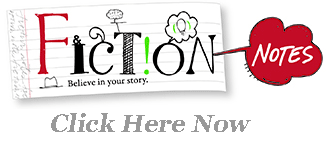 Visit Our EBOOK STORE! | 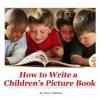 How to Write a Picture Book. Ebook, immediate download. $10. How to Write a Picture Book. Ebook, immediate download. $10. |
Blog: Through The Tollbooth (Login to Add to MyJacketFlap)
JacketFlap tags: backstory, flashbacks, helen hemphill, Add a tag
We've talked all this week about the challenges of writing backstory in summary. Specific details about the past events of a novel may need to be given to the reader, but less is more. Don't tell too much, and be selective and succinct when choosing the details to reveal. But what happens when you need to show the reader a scene? Chances are you will consider writing a flashback.
Technically, a flashback is a shift in the narrative that temporary stops the forward motion of the story. The trick is, of course, to make sure that that temporary stop informs your narrative, rather than distracting from it.
Unlike prologues, I don’t mind flashbacks. In fact, they can deepen the reader’s understanding of a story by showing character emotions and plot twists. But again, less is more. If done too much, a flashback can stop the forward movement of the narrative arc. If done without specific clarity, a flashback and confuse readers, especially reluctant readers.
So, here’s a tip sheet for writing flashback:
- Use verb tense as a way of showing the change in time. If you novel is written in present tense, your flashback should be written in past tense. If the main body of your story is told in past tense, then begin your flashback in past perfect, but transition to simple past tense within two or three sentences.
- Make sure the reader clearly is grounded in the time and place of your flashback. Give them a sentence or two with information about where and when, but as with summary backstory, don’t give too much. After the flashback is over, again ground readers in the present with details of time and place.
- Does your flashback have some kind of trigger that makes the flashback work for the reader at precisely that moment. Maybe it follows a strong action scene, or maybe it follows a reversal in the story. Either way, think about the purpose of the flashback. Does it reveal character? Does it give the reader important information they must know? Does it somehow inform the present? And does it come at a point in the plot so that it is the natural consequence of a plot point or character action?
- Unless you are doing a time travel novel, the same rule applies here for both summary and scene. When in doubt, see if you can get the same information to the reader without using the flashback. If you can, skip the flashback and stay with the story.
- Finally, don’t start a story with a flashback. It’s like using a prologue, and you know how I feel about that.

Next week on the tollbooth, Kelly will be here. Enjoy the weekend. Anon. HH
Blog: Adventures in YA Publishing (Login to Add to MyJacketFlap)
JacketFlap tags: Backstory, Plotting, The Craft of Writing, K. M. Weiland, Add a tag
View the video at: http://wordplay-kmweiland.blogspot.com/2010/03/how-to-tell-if-your-backstory-is-boring.html
I like to think of the process of cutting backstory as maintaining urgency. If my backstory interferes with the reader's need to know what happens next, I have to cut it. And I know and angst about every single spot in my work where I have to incorporate backstory and can't do so in the midst of conflict. Seeing the video this morning inspired me to go back and revisit a couple of scenes. My thought for the day: backstory creeps on sneaky feet.
Happy writing,
Martina Add a Comment
Blog: Through The Tollbooth (Login to Add to MyJacketFlap)
JacketFlap tags: prologue, backstory, the book thief, helen hemphill, Add a tag
In most novels, the prologue is nothing more than a blah blah blah of backstory. As a reader, I like the backstory woven into the action. I want to speculate about the story in an interactive way, and the prologue tips the writer’s hand.
 Marcus Zusak’s The Book Thief is a brilliant book on so many levels I don’t even know where to begin. I loved the book, but I hated the prologue. Let’s take a look for a minute:
Marcus Zusak’s The Book Thief is a brilliant book on so many levels I don’t even know where to begin. I loved the book, but I hated the prologue. Let’s take a look for a minute:- A girl
- Some words
- An accordionist
- Some fanatical Germans
- A Jewish fish fighter
- And quite a lot of thievery
Blog: Plot Whisperer for Writers and Readers (Login to Add to MyJacketFlap)
JacketFlap tags: memory, The Beginning, Backstory, flashbacks, holiday plot guide for writers, linear story line, Add a tag
 A problem I often find in the plot consultations I provide is the misuse of flashbacks.
A problem I often find in the plot consultations I provide is the misuse of flashbacks.
During a plot consultation, a writer outlines her historical novel to me. Before long, the story takes a u-turn into flashback. My immediate reaction is to refocus myself. I quickly scan the Plot Planner I am creating for her for what I know of the story so far ~ the time frame, the place, and the characters ~ in order to keep in perspective the time and place change.
If you've read Blockbuster Plots Pure & Simple, you know I am not a fan of flashback. Mostly, I dislike the whiplash effect, but also because I have seen too many writers, especially writers just starting out, overuse and abuse flashback. It is more difficult and takes more thought and creativity to integrate the pertinent backstory seamlessly into the front-story than it is to create a flashback. Flashback is a depiction of a past, literal experience. Full integration of back-story into front-story involves more nuance and skill.
Three plot tips when it comes to flashbacks:
1) If you feel you just have to have a flashback, wait to use it in the Middle of the story. By then, the reader has had time to ground themselves in the front-story and is better able to transition back and forth in time
2) A flashback is portrayed moment-by-moment in scene. Consider instead using a memory (summary)
3) If flashbacks are integral to the overall plot and structure, do like Audrey Niffenegger in The Time Traveler's Wife, make the story line non-linear and create the very structure of your story based on time jumps.
Blog: Ellis Nadler's Sketchbook (Login to Add to MyJacketFlap)
JacketFlap tags: Nadler, snake, subconscious, engraving, print, religion, animals, mythology, cloud, print, subconscious, Nadler, snake, engraving, Add a tag
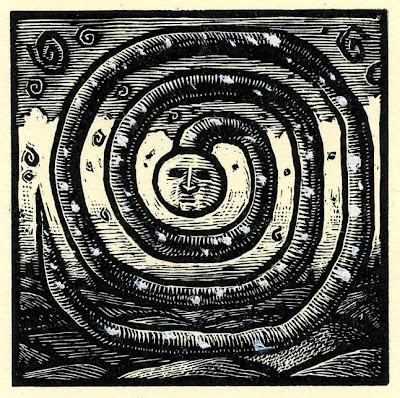 Can't decide whether the cosmic serpent had spots or not.
Can't decide whether the cosmic serpent had spots or not.
Proof of wood engraving with gouache paint dots. 5cm x 5cm. Click to enlarge.
Blog: OUPblog (Login to Add to MyJacketFlap)
JacketFlap tags: publishing, industry, Business, Technology, Blogs, amazon, digital, Media, ebooks, A-Featured, Online Resources, schnittman, evan, ebook, online, print, oupblog, sony, kindle, ereader, chesil, Add a tag
Recently I was on an airplane reading an article in the New York Times when the woman in the seat next to me leaned over and asked what I was holding. I told her it was a Kindle, Amazon’s new ebook reader. I showed her how it worked, explained e-ink, walked her through my collection of titles and subscriptions, and showed how I could look up words in the built in Oxford dictionary. Her response; “That is really cool, but I prefer the feel and smell of a real book.” (more…)
Blog: Ellis Nadler's Sketchbook (Login to Add to MyJacketFlap)
JacketFlap tags: dog, religion, animals, mythology, people, death, print, psychology, subconscious, sword, Nadler, nude, linocut, Add a tag
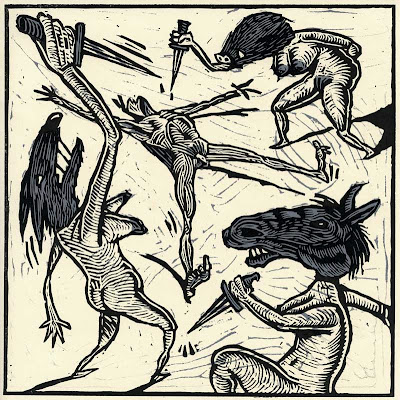 Just finished "Side Effects" by Adam Phillips.
Just finished "Side Effects" by Adam Phillips.
2-colour lino cut 25cm x 25cm. Click to enlarge.
Blog: Ellis Nadler's Sketchbook (Login to Add to MyJacketFlap)
JacketFlap tags: people, machine, print, beard, shoes, sculpture, hat, Nadler, linocut, Add a tag
 Dennett's Beard.
Dennett's Beard.
Lino cut 20cm x 25cm. Click to enlarge.
View Next 13 Posts







Great tips on backstory. I agree that mostly dripping it in is best.
The best advice I've heard is write the backstory, then act like it's a piece of glass. Drop it. Let it shatter. And add the slivers of backstory into your story. Works for me. :D
I'm writing a first draft right now and I'm just letting the words flow. I've got all kinds of comments to myself through it like... (this is all telliing!) (backstory alert!) I don't want to stop the flow of the words right now, but I know it needs a lot of work in that 2nd draft! :)
That is a BIG picture of me - yikes! Thanks for answering my question so quickly. I like the drip, drip method, and Stina's slivers of glass. I tend to have multiple paragraphs of backstory and then have to pare it waaaaayyyy down.
I think backstory is tricky. Well, everything is tricky....but I usually find that I don't include enough! Crit partners want to know more. :)
Adding back-story can definitely be challenging, but I agree, "dripping" it in is the best method. No one should rely on doing it through dialogue when all the other characters are already in-the-know, unless you want that same dialogue to come across as incredibly fake and clunky....
My current WIP could easily contain A LOT of backstory, and yes, it's challenging to get it in. While I've been "dripping" it in here and there as my protag discovers key items, there is a point in which she meets an important secondary character who is in a position to tell her about her father's life (my protag's father died 20 years prior). While this secondary character doesn't tell the protag everything under the sun, she does provide historical details about halfway through the story.
So far my beta readers love it. Let's see what my sharp-eyed crit partner thinks when she gets to it. ;)
As always Lisa, another thought-provoking post from you! Thank you! :)
Great tips, Lisa. I love, love, love it when I learn tiny bits of backstory along the way. It keeps me curious.
I'm all for the drip-factor.
Love the drip by drip. Hate the dump. Worry a lot about backstory when I'm writing. Guess this was the perfect post for me to read. Thanks.
Interesting that in some other cases I can think of, it's also the world itself that shows it best, rather than a character. Though you can use almost any character or setting to spark a memory in your main character's head that can reveal a "drip" of backstory.
That's such a great image - dropping a piece of glass and adding the slivers!
The drip, drip, drip of information is perfect. Information dumps are so obvious and awkward. Backstory is tricky, but when it works, it's amazing.
Wow! This is a GREAT way to distinguish what makes effective backstory and what kills it! Thanks, Vicki! I've never known how to put it in words. The main story has to be the main story. It's like good cooking. Backstory is the seasoning. :o) <3
I think you've nailed it - this is pretty much it. :) Great post, and great advice!